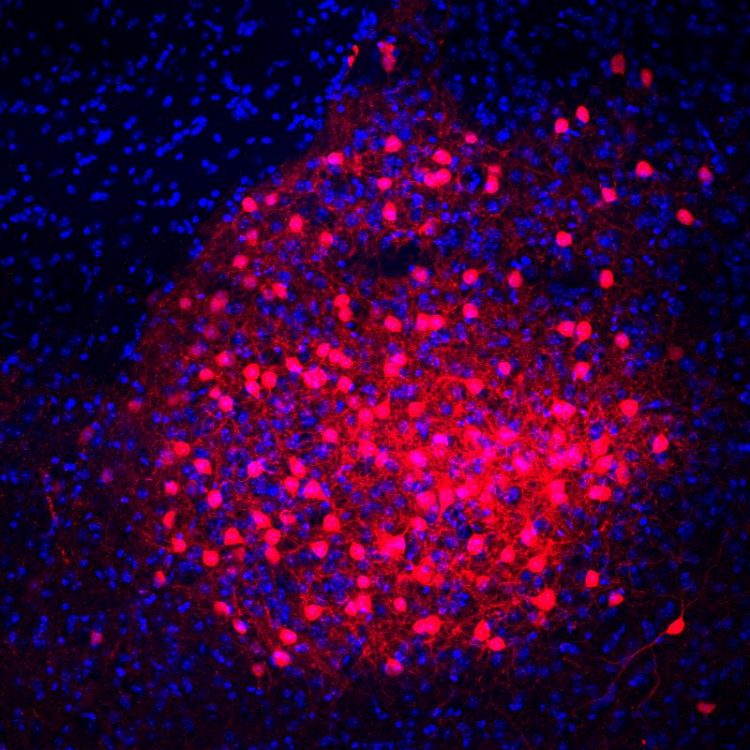Understanding anxiety – Neural circuit mechanisms of emotion identified

CRH neurons (red) in the amygdala MPI of Psychiatry
In a previous study, published in Science in 2011, Jan Deussing’s group revealed for the first time that corticotropin releasing hormone (CRH) signaling in dopaminergic neurons of the ventral tegmental area (VTA) can suppress anxiety.
In their latest study, Deussing’s group has expanded on these findings, providing more mechanistic insights into the “anxiolytic” CRH circuit. Published in the prestigious journal Nature Neuroscience, the scientists describe how the circuit originates in the extended amygdala, in a population of GABAergic neurons that produce CRH.
They traced these neurons and saw that they project down to a region of the midbrain called the VTA, one of the main dopamine-producing areas of the brain. The VTA is known to play a key role in reward and addiction, but here the authors explain how CRH and dopamine interact in anxiety-related behavior.
The CRH-containing projection neurons of the extended amygdala target CRH receptors on dopaminergic VTA neurons. As a result, this circuit can regulate dopaminergic transmission and in turn, emotional behavior.
Lead author of the current study Nina Dedic explains the significance of the findings: “We know that CRH is a major driver of the stress response and that a hyperactive CRH system is implicated in neuropsychiatric pathologies such as mood and anxiety disorders. However, in this study, we could show that CRH does not always act as an aversive, stress-inducing neuropeptide. In fact, specific CRH circuits are required to maintain a positive affective state under normal, stress-free conditions.”
Deussing, research group leader and head of the study explains: “We were surprised to find that a subset of GABAergic CRH neurons in the extended amygdala carry dendritic spines and co-express the postsynaptic density protein, Camk2a. These characteristics are more commonly seen in excitatory, glutamatergic neurons.”
He continues: “Our work suggests that CRH neurons in the extended amygdala are more diverse than we had originally thought. There are locally projecting interneurons as well as spiny, GABAergic, long-range projection neurons.”
In addition to revealing how CRH interacts with dopamine to regulate anxiety, Deussing’s group hopes that these findings will help to unravel the complex stress circuits and networks of the brain.
Media Contact
All latest news from the category: Life Sciences and Chemistry
Articles and reports from the Life Sciences and chemistry area deal with applied and basic research into modern biology, chemistry and human medicine.
Valuable information can be found on a range of life sciences fields including bacteriology, biochemistry, bionics, bioinformatics, biophysics, biotechnology, genetics, geobotany, human biology, marine biology, microbiology, molecular biology, cellular biology, zoology, bioinorganic chemistry, microchemistry and environmental chemistry.
Newest articles

Sea slugs inspire highly stretchable biomedical sensor
USC Viterbi School of Engineering researcher Hangbo Zhao presents findings on highly stretchable and customizable microneedles for application in fields including neuroscience, tissue engineering, and wearable bioelectronics. The revolution in…

Twisting and binding matter waves with photons in a cavity
Precisely measuring the energy states of individual atoms has been a historical challenge for physicists due to atomic recoil. When an atom interacts with a photon, the atom “recoils” in…

Nanotubes, nanoparticles, and antibodies detect tiny amounts of fentanyl
New sensor is six orders of magnitude more sensitive than the next best thing. A research team at Pitt led by Alexander Star, a chemistry professor in the Kenneth P. Dietrich…





















